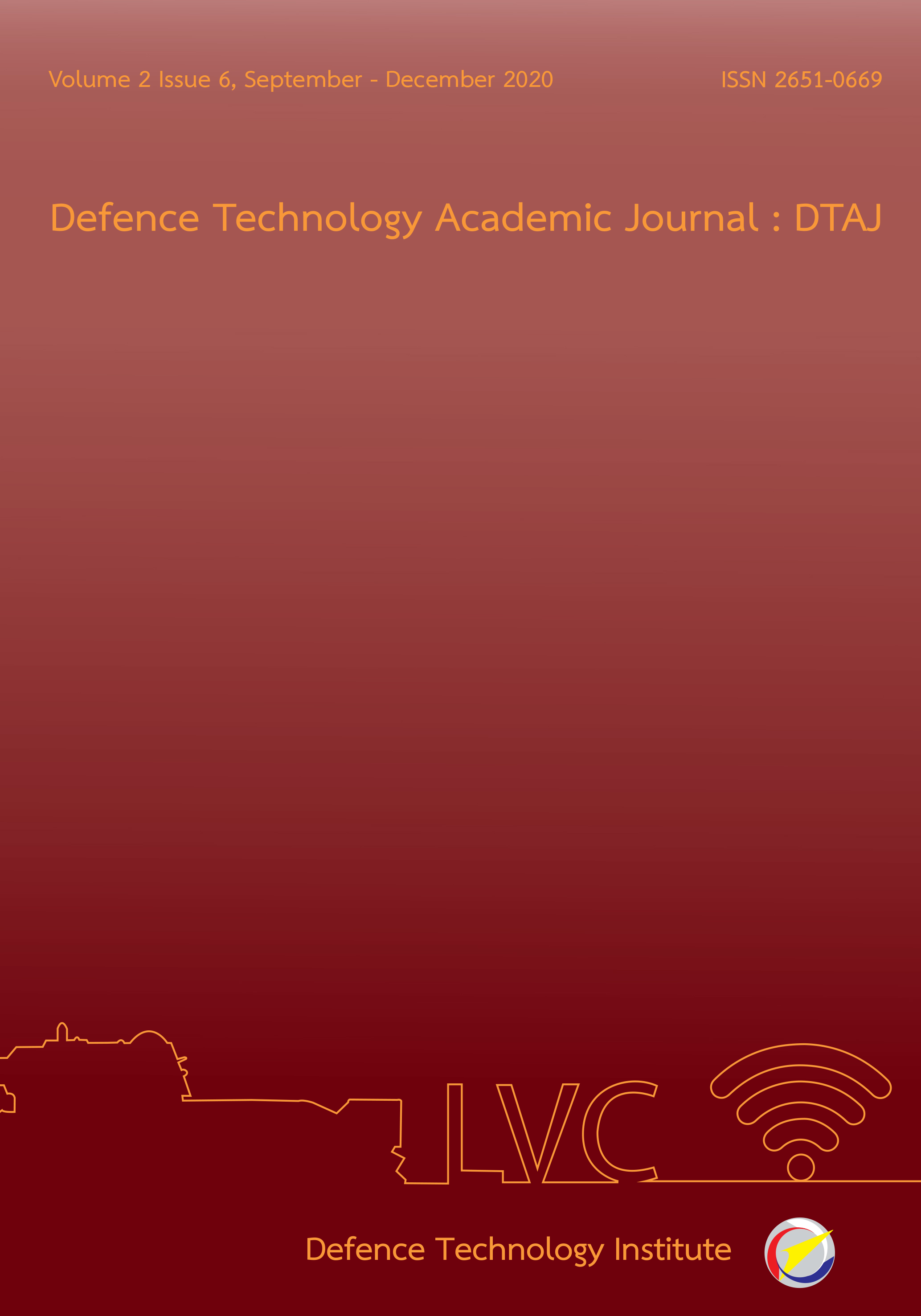Effects of Layer Arrangements on Bullet Protection Capability of Armor Plate
Main Article Content
Abstract
High strength steel bulletproof plate can be made into single- or multiple-layered plate. The layer arrangement clearly influences the protection capability of the entire plate. This project aims to analyze the effect of layer arrangement on the protection capability of armour plate. An Armox500T plate was selected as the representative material. It was tested according to National Institute of Justice (NIJ) threat level 3. Experimental results demonstrated underlying deformation mechanisms of steel plate that served as validating data for a finite element model. The model was shown to correctly predict the deformed thickness and the penetrated hole of the steel plate. This validated model was modified to investigate the effects of arrangement and thickness of layers. The analysis showed that the double-layered plate is able to dissipate the impact energy of the bullet more than the single layer counterpart with the same total thickness because the thinner plates were bent out of the original shape, consuming greater impact energy and resulting in a larger deformation.
Downloads
Article Details

This work is licensed under a Creative Commons Attribution-NonCommercial-NoDerivatives 4.0 International License.
Journal of TCI is licensed under a Creative Commons Attribution-NonCommercial-NoDerivatives 4.0 International (CC BY-NC-ND 4.0) licence, unless otherwise stated. Please read our Policies page for more information...
References
Alavi Nia, A., Hoseini, G.R. “Experimental study of perforation of multi-layered target by hemispherical-nosed projectiles”, Materials
and Design, 32, 2011, pp. 1057-1065.
Almohandes, A.A., Abdel-Kader, M.S., Eleiche, A.M. “Experimental investigation of the ballistic resistance of steel-fiberglass reinforced polyester laminated plates”, Composites Part B: Engineering, 27(5), 1996, pp. 447-458.
Corran, R.S.J., Shadbolt, P.J., Ruiz, C. “Impact loading of plates – an experimental investigation”, International Journal of Impact
Engineering, 1(1), 1983, pp. 3-22.
Gupta, N.K., Madhu, V. “An experimental study of normal and oblique impact of hard-core projectile on single and layered plates”, International Journal of Impact Engineering, 19(97), 1997, pp. 395-414.
Palta, E., Gutowski, M., Fang, H.B. “A numerical study of steel and hybrid armor plates under ballistic impacts”, International Journal of Solids and Structures, 136-137 (2018), pp. 279-294.
Zukas, J.A., Scheffler, D.R. “Impact effects in multilayered plates”, International Journal of Solids and Structures, 38, 2001, pp. 3321-3328.
Holmen, J.K., Solberg, J.K., Hopperstad, O.S., Borvik, T. “Ballistic impact of layered and case-hardened steel plates”, International
Journal of Impact Engineering, 110, 2017, pp. 4-14.
Liu, J.F., Long, Y., Ji, C., Liu, Q., Zhong, M.S., Ge, S. “Ballistic performance study on the composite structures of multi-layered targets subjected to high velocity impact by copper EFP”, Composite Structures, 184, 2018, pp. 484-496.
Liu, J.F., Long, Y., Ji, C., Liu, Q., Zhong, M.S., Zhou, Y. “Influence of layer number and air gap on the ballistic performance of multi-layered targets subjected to high velocity impact by copper EFP”, International Journal of Impact Engineering, 112, 2018, pp. 52-65.
Serjouei, A., Gour, G., Zhang, X.F., Idapalapati, S., Tan, G.E.B. “On improving ballistic limit of bi-layer ceramic-metal armor”, International Journal of Impact Engineering, 105, 2017, pp. 54-67.
Ben-dor, G., Dubinsky, A., Elperin, T. “On the ballistic resistance of multi-layered targets with air gaps”, International Journal of Solids and Structures, 35(23), 1998, pp. 3097-3103.
Elek, P., Jaramaz, S., Mickovic, D. “Modeling of perforation of plates and multi-layered metallic targets”, International Journal of Solids and Structures, 42, 2005, pp. 1209-1224.
Iqbal, M.A., Senthil, K., Sharma, P., Gupta, N.K. “An investigation of the constitutive behavior of Armox 500T steel and armor piercing incendiary projectile material” International Journal of Impact Engineering, 2016, pp. 146-164.
ABAQUS Documentation, Simulia. [15] Adam, B (2003). “Simulation of ballistic impacts on armored civil vehicles” Master Thesis, Eindhoven University of Technology, The Netherlands.


